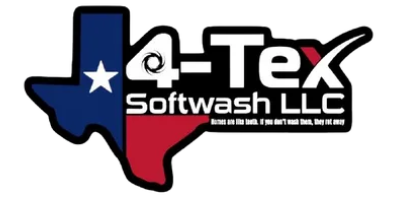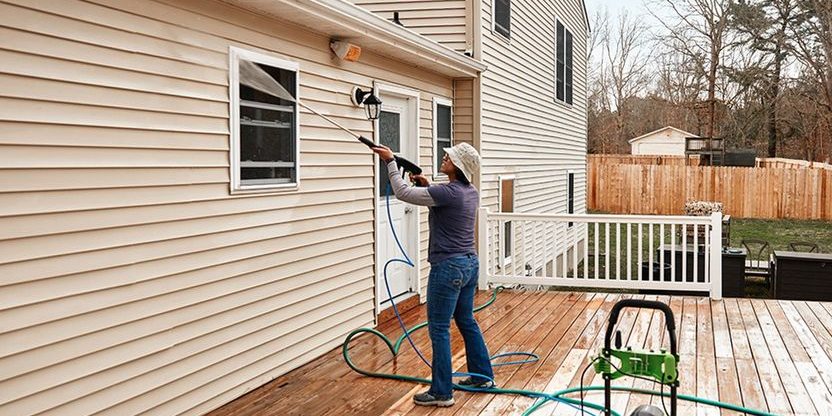House washing, an often overlooked aspect of home maintenance, plays a crucial role in preserving the aesthetic and structural integrity of your home. This guide dives deep into the nuances of house washing, offering you insights into its importance, varied techniques, and the benefits it brings to the table. Whether you’re a seasoned homeowner or a newcomer to this task, this article promises to equip you with all the necessary information to master the art of house washing.
Understanding House Washing:
Defining House Washing:
House washing is cleaning the exterior surfaces of your home to remove accumulated dirt, grime, and other unsightly substances. This routine maintenance extends beyond mere aesthetics, contributing significantly to the longevity of your home’s exterior.
Benefits of Regular House Washing:
Engaging in regular house washing not only enhances the curb appeal of your home but also plays a pivotal role in warding off potential damages caused by the long-term accumulation of harmful substances. Additionally, a well-maintained exterior can contribute to an increase in your property’s market value, making house washing a wise investment.
Differentiating Between House Washing and Pressure Washing:
It’s crucial to understand the difference between house washing and pressure washing. House washing often involves gentler methods, suitable for a variety of surfaces, whereas pressure washing uses high-pressure water spray, ideal for tougher, more resilient surfaces.
Preparing for House Washing:
Inspecting Your Home’s Exterior:
The first step in house washing involves a thorough inspection of your home’s exterior. Look for any damages that need repair, identify areas that require special attention during cleaning, and assess the type of dirt and stains present.
Necessary Tools and Equipment:
Gathering the right tools and equipment is essential for effective house washing. This includes items such as a garden hose, soft-bristled brushes, cleaners suitable for your home’s exterior, and a pressure washer if necessary.
Safety Precautions to Consider:
Safety cannot be overstated when it comes to house washing. Wear protective clothing, ensure that any ladders used are stable and secure, and be cautious when handling chemicals or operating high-pressure washers.
DIY House Washing Techniques:
Choosing the Right Cleaning Solutions:
Selecting the appropriate cleaning solutions is crucial. Opt for eco-friendly and surface-appropriate cleaners to avoid damaging your home’s exterior or the environment.
Step-by-Step Guide to DIY Washing:
Begin with a gentle rinse to remove loose dirt. Apply your chosen cleaning solution from the bottom up to avoid streaking, and use a soft-bristled brush for scrubbing. Rinse thoroughly to prevent residue build-up.
Tips for Effective and Safe Cleaning:
To ensure effective cleaning, tackle one section at a time and avoid washing in direct sunlight to prevent quick drying of the solution. Always adhere to the manufacturer’s instructions for both the cleaning solutions and any equipment used.
Professional House Washing Services:
When to Hire a Professional:
In certain situations, such as dealing with extensive grime, hard-to-reach areas, or surfaces requiring special care, it may be prudent to hire professional housewashing services.
What to Look for in a Service Provider:
When selecting a professional service, look for providers with good reputations, substantial experience, and the necessary insurance. Reviews and testimonials can be a great guide in making your choice.
Cost vs. Benefit Analysis:
Consider the costs involved against the benefits of professional expertise, time-saving, and the potential for long-term maintenance benefits. In many cases, the investment in a professional service can be justified by the superior results and peace of mind it offers.
The Role of Pressure Washing in House Cleaning:
Understanding Pressure Washing:
Pressure washing is a powerful method used to remove tough dirt and grime. While effective, it requires careful handling to avoid damage to your home’s surfaces.
Pros and Cons of Pressure Washing:
The major advantages of pressure washing include its efficiency and effectiveness against stubborn stains and build-ups. The downside, however, is the potential for damage if not done correctly, especially on softer or more delicate surfaces.
Best Practices for Pressure Washing:
Use pressure washing primarily for hard surfaces like driveways, patios, and certain types of siding. Start with a lower pressure setting and maintain a safe distance from the surface to prevent damage. Always test a small, inconspicuous area first.
Eco-Friendly House Washing Options:
Environmentally Safe Cleaning Solutions:
In today’s environmentally conscious world, choosing biodegradable and non-toxic cleaning agents is more important than ever. These solutions are effective at cleaning while being gentle on the planet.
Techniques That Minimize Environmental Impact:
Adopt techniques that conserve water and prevent pollutants from washing into storm drains. This not only protects the environment but often complies with local regulations aimed at preserving natural water sources.
Benefits of Eco-Friendly Washing:
Eco-friendly house washing not only benefits the environment but also ensures the safety of your family and pets. Additionally, such practices often align with growing consumer trends toward sustainability.
Common House Washing Mistakes to Avoid:
Over-Washing and Potential Damages:
Avoid the temptation to over-wash. Excessive washing or using overly aggressive techniques can lead to damage such as stripped paint, eroded siding, and water intrusion.
Misusing Chemicals and Equipment:
The misuse of chemicals and equipment can result in ineffective cleaning, damage to surfaces, and even personal injury. Always follow the recommended guidelines for any cleaning agents and machinery.
Ignoring Safety Procedures:
Safety should always be a top priority. Common mistakes include neglecting proper ladder safety, mishandling high-pressure washers, and improper use of cleaning chemicals. Ensuring you follow proper safety protocols can prevent accidents and injuries.
Seasonal Considerations in House Washing:
Best Time of the Year for House Washing:
Timing is everything when it comes to house washing. The best times are typically spring and autumn. These seasons provide moderate temperatures and are ideal for preparing your home’s exterior for the more extreme conditions of summer and winter.
Preparing Your House for Different Seasons:
Adapting your cleaning approach to the season is important. For instance, addressing mildew and pollen in the spring or clearing leaves and debris in the autumn can be crucial for maintaining your home’s exterior.
Special Considerations for Harsh Climates:
Special considerations must be taken in harsh climates, whether it be extreme cold, heat, humidity, or coastal conditions. For example, in coastal areas, salt accumulation can be a significant issue, while in humid regions, the growth of mold and mildew can be more prevalent.
Long-Term Maintenance After House Washing:
Routine Maintenance Tips:
After house washing, regular maintenance is key. This includes tasks such as cleaning gutters, inspecting for signs of mold or algae growth, and touching up areas where paint may be peeling or chipped.
Protecting Your Home’s Exterior Post-Washing:
Post-washing, consider applying protective sealants where appropriate to extend the life of your home’s surfaces. Addressing any small issues promptly can prevent larger, more costly problems down the line.
Scheduling Regular Cleanings:
Establishing a routine cleaning schedule is essential. Depending on your geographical location and the exposure of your home to natural elements, an annual or biannual house washing can be optimal.
The Future of House Washing:
Innovations in House Washing Techniques:
The future of house washing is likely to see continued innovation in cleaning techniques and methods. These advancements promise more effective, efficient, and environmentally friendly ways to maintain the exteriors of homes.
Trends in Eco-Friendly Solutions:
The trend towards more eco-friendly cleaning solutions and practices is expected to continue, driven by growing environmental awareness and consumer demand for sustainable practices.
Predictions for the House Washing Industry:
Advancements in cleaning solutions, equipment technology, and a greater focus on eco-friendly and sustainable practices are expected to shape the future of the housewashing industry.
Frequently Asked Questions (FAQs)
What is house washing?
House washing is the process of cleaning the exterior of a house to remove dirt, grime, mold, mildew, and other build-ups from surfaces like siding, brick, and stucco.
Why is housewashing important?
Regular house washing maintains the aesthetic appeal of your home, prevents long-term damage from harmful substances, and can increase property value.
How often should I wash my house?
It’s generally recommended to wash your house every 1-2 years, but this can vary based on local climate conditions and the house’s exposure to elements.
Can I do house washing myself or should I hire professionals?
While DIY house washing is possible, hiring professionals is advisable for safety reasons and to ensure a thorough and damage-free cleaning, especially for hard-to-reach areas or delicate surfaces.
What is the difference between house washing and pressure washing?
House washing often uses lower pressure and sometimes chemical cleaners to clean surfaces, while pressure washing uses high-pressure water to remove tough grime and stains gently.
Is house washing environmentally friendly?
It can be, especially if you use eco-friendly cleaning solutions and techniques that minimize environmental impact, like avoiding harmful chemicals and conserving water.
What equipment is needed for house washing?
Basic equipment includes a garden hose, soft-bristled brushes, appropriate cleaning solutions, and possibly a low-pressure washer.
Can house washing damage my home?
If not done properly, house washing can cause damage. It’s important to use the right techniques and pressures for different surfaces to avoid harm.
How long does house washing take?
The time taken for house washing varies depending on the size of your home and the method used, but it typically takes a few hours.
What should I do to prepare my home for washing?
Clear the exterior area of personal items, cover plants and outdoor furniture, close all windows and doors, and ensure that any external electrical outlets are protected.
Are there any safety concerns with house washing?
Safety concerns include using ladders, handling pressure washers, and dealing with cleaning chemicals. Proper safety gear and awareness are essential.
What are the best conditions for house washing?
Ideal conditions are a dry, overcast day to prevent quick drying of cleaning solutions and to ensure a thorough clean.
Conclusion:
House washing is a vital part of maintaining the health and appearance of your home. By understanding the correct techniques, choosing the right methods, and being mindful of the environmental impact, you can ensure your home remains a beautiful and safe place for years to come. Remember, a clean home is not just a visually pleasing one; it’s also a testament to responsible homeownership and care.

